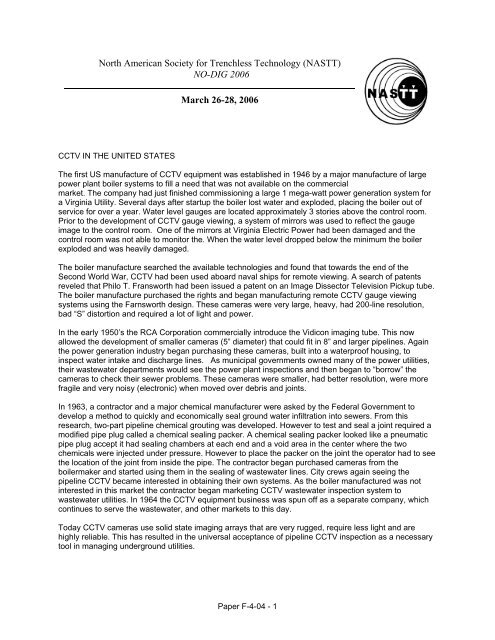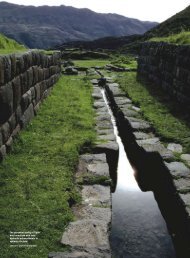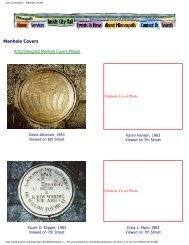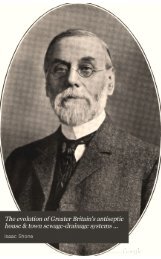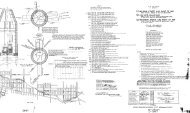our discussion on CCTV United States - The History of Sanitary ...
our discussion on CCTV United States - The History of Sanitary ...
our discussion on CCTV United States - The History of Sanitary ...
Create successful ePaper yourself
Turn your PDF publications into a flip-book with our unique Google optimized e-Paper software.
North American Society for Trenchless Technology (NASTT)<br />
NO-DIG 2006<br />
<strong>CCTV</strong> IN THE UNITED STATES<br />
March 26-28, 2006<br />
<strong>The</strong> first US manufacture <strong>of</strong> <strong>CCTV</strong> equipment was established in 1946 by a major manufacture <strong>of</strong> large<br />
power plant boiler systems to fill a need that was not available <strong>on</strong> the commercial<br />
market. <strong>The</strong> company had just finished commissi<strong>on</strong>ing a large 1 mega-watt power generati<strong>on</strong> system for<br />
a Virginia Utility. Several days after startup the boiler lost water and exploded, placing the boiler out <strong>of</strong><br />
service for over a year. Water level gauges are located approximately 3 stories above the c<strong>on</strong>trol room.<br />
Prior to the development <strong>of</strong> <strong>CCTV</strong> gauge viewing, a system <strong>of</strong> mirrors was used to reflect the gauge<br />
image to the c<strong>on</strong>trol room. One <strong>of</strong> the mirrors at Virginia Electric Power had been damaged and the<br />
c<strong>on</strong>trol room was not able to m<strong>on</strong>itor the. When the water level dropped below the minimum the boiler<br />
exploded and was heavily damaged.<br />
<strong>The</strong> boiler manufacture searched the available technologies and found that towards the end <strong>of</strong> the<br />
Sec<strong>on</strong>d World War, <strong>CCTV</strong> had been used aboard naval ships for remote viewing. A search <strong>of</strong> patents<br />
reveled that Philo T. Fransworth had been issued a patent <strong>on</strong> an Image Dissector Televisi<strong>on</strong> Pickup tube.<br />
<strong>The</strong> boiler manufacture purchased the rights and began manufacturing remote <strong>CCTV</strong> gauge viewing<br />
systems using the Farnsworth design. <strong>The</strong>se cameras were very large, heavy, had 200-line resoluti<strong>on</strong>,<br />
bad “S” distorti<strong>on</strong> and required a lot <strong>of</strong> light and power.<br />
In the early 1950’s the RCA Corporati<strong>on</strong> commercially introduce the Vidic<strong>on</strong> imaging tube. This now<br />
allowed the development <strong>of</strong> smaller cameras (5” diameter) that could fit in 8” and larger pipelines. Again<br />
the power generati<strong>on</strong> industry began purchasing these cameras, built into a waterpro<strong>of</strong> housing, to<br />
inspect water intake and discharge lines. As municipal governments owned many <strong>of</strong> the power utilities,<br />
their wastewater departments would see the power plant inspecti<strong>on</strong>s and then began to “borrow” the<br />
cameras to check their sewer problems. <strong>The</strong>se cameras were smaller, had better resoluti<strong>on</strong>, were more<br />
fragile and very noisy (electr<strong>on</strong>ic) when moved over debris and joints.<br />
In 1963, a c<strong>on</strong>tractor and a major chemical manufacturer were asked by the Federal Government to<br />
develop a method to quickly and ec<strong>on</strong>omically seal ground water infiltrati<strong>on</strong> into sewers. From this<br />
research, two-part pipeline chemical grouting was developed. However to test and seal a joint required a<br />
modified pipe plug called a chemical sealing packer. A chemical sealing packer looked like a pneumatic<br />
pipe plug accept it had sealing chambers at each end and a void area in the center where the two<br />
chemicals were injected under pressure. However to place the packer <strong>on</strong> the joint the operator had to see<br />
the locati<strong>on</strong> <strong>of</strong> the joint from inside the pipe. <strong>The</strong> c<strong>on</strong>tractor began purchased cameras from the<br />
boilermaker and started using them in the sealing <strong>of</strong> wastewater lines. City crews again seeing the<br />
pipeline <strong>CCTV</strong> became interested in obtaining their own systems. As the boiler manufactured was not<br />
interested in this market the c<strong>on</strong>tractor began marketing <strong>CCTV</strong> wastewater inspecti<strong>on</strong> system to<br />
wastewater utilities. In 1964 the <strong>CCTV</strong> equipment business was spun <strong>of</strong>f as a separate company, which<br />
c<strong>on</strong>tinues to serve the wastewater, and other markets to this day.<br />
Today <strong>CCTV</strong> cameras use solid state imaging arrays that are very rugged, require less light and are<br />
highly reliable. This has resulted in the universal acceptance <strong>of</strong> pipeline <strong>CCTV</strong> inspecti<strong>on</strong> as a necessary<br />
tool in managing underground utilities.<br />
Paper F-4-04 - 1
HISTORY OF <strong>CCTV</strong> IN THE UNITED STATES<br />
Welcome to <str<strong>on</strong>g>our</str<strong>on</strong>g> <str<strong>on</strong>g>discussi<strong>on</strong></str<strong>on</strong>g> <strong>of</strong> Closed Circuit Televisi<strong>on</strong> (<strong>CCTV</strong>) in the <strong>United</strong> <strong>States</strong>. First we should start<br />
with the definiti<strong>on</strong> <strong>of</strong> the word sewer, which many believe has its’ roots in the Old English word seaward.<br />
<strong>The</strong> old sewers in England were open ditch style and led towards the Thames River which then flowed<br />
towards the sea. <strong>The</strong>refore the liquid in the ditch was referred to as seaward.<br />
<strong>The</strong> earliest pipe recorded in use in the <strong>United</strong> <strong>States</strong> was simply hollowed out logs which carried sewage<br />
from a single dwelling the nearest stream. This <strong>of</strong> c<str<strong>on</strong>g>our</str<strong>on</strong>g>se polluted the waterways and was not in use for<br />
l<strong>on</strong>g before sewage system in more urban towns became comm<strong>on</strong>place.<br />
Figure 1. Advertisement for Redwood (Stave) Pipe<br />
Manufacturer: California Redwood Pipe Company (Los Angeles, CA).<br />
S<str<strong>on</strong>g>our</str<strong>on</strong>g>ce: 1924 Classified Buyer's Guide <strong>of</strong> the City <strong>of</strong> M<strong>on</strong>rovia, CA.<br />
After we started with sewer systems, the need for inspecti<strong>on</strong> and cleaning quickly arose. <strong>The</strong> beginning <strong>of</strong><br />
sewer line inspecti<strong>on</strong> was not with <strong>CCTV</strong>, but rather a primitive test which was <strong>on</strong>ly really capable <strong>of</strong><br />
finding infiltrati<strong>on</strong> or a failure <strong>of</strong> the so called inspecti<strong>on</strong> method.<br />
Figure 2. Lamp-hole Designs<br />
S<str<strong>on</strong>g>our</str<strong>on</strong>g>ce: <strong>The</strong> Designing, C<strong>on</strong>structi<strong>on</strong>, and Maintenance <strong>of</strong> Sewerage Systems,<br />
by H. Prescott Folwell, 1901<br />
<strong>The</strong> first holes which were used to access the collecti<strong>on</strong> systems were referred to as lamp holes. <strong>The</strong>y<br />
were <strong>on</strong>ly large enough to lower a lamp which was used to see if light would appear at the other end. <strong>The</strong><br />
interesting part <strong>of</strong> these early inspecti<strong>on</strong>s is that no camera was used, these lamp holes were used to<br />
lower a candle and in later years the candle was dragged from <strong>on</strong>e manhole to another by floating a thin<br />
line, such as a fishing line downstream with the flow and then retrieving it at the downstream manhole.<br />
This thread was then used to allow the operator to later pull a sled or a wag<strong>on</strong> through the line. On the<br />
Paper F-4-04 - 2
sled or the wag<strong>on</strong> a candle would be placed. It was felt that, if the candle would still be lit at the far end if<br />
there was not a problem with the line. If infiltrati<strong>on</strong> occurred, then it was thought that the candle would be<br />
extinguished. This <strong>of</strong> c<str<strong>on</strong>g>our</str<strong>on</strong>g>se also remained true if the candle went past a lateral with flow, or rolled over<br />
during the inspecti<strong>on</strong> also. Not much useful informati<strong>on</strong> was gathered. At the end <strong>of</strong> the day, the operator<br />
would have a simple set <strong>of</strong> data which showed if a line passed or failed. A failure usually meant a reinspecti<strong>on</strong>.<br />
If an actual failure did indeed occur, then operator still had no idea where in the line the<br />
infiltrati<strong>on</strong> occurred.<br />
Early pipe was built in 2’ secti<strong>on</strong>s and was not sealed at the joints as it was felt that a little ground water<br />
infiltrati<strong>on</strong> would increase the velocity <strong>of</strong> the pipe and thereby increase its’ self cleaning ability. Later<br />
proper c<strong>on</strong>structi<strong>on</strong> analysis disproved this and 3’ pipe lengths were introduced as the dirt and debris was<br />
entering the line causing blockages. <strong>The</strong> use <strong>of</strong> sealant became proper c<strong>on</strong>structi<strong>on</strong> method. <strong>The</strong> early<br />
lamp holes were slowly replaced with manholes. <strong>The</strong> manholes provided two purposes. Firstly, they<br />
allowed access to the collecti<strong>on</strong> system for maintenance purposes. Sec<strong>on</strong>dly, they provided much<br />
needed ventilati<strong>on</strong>. Earliest plumbing didn’t have water filled traps and the larger manholes with<br />
ventilati<strong>on</strong> lids allowed the ventilati<strong>on</strong> required to remove the od<str<strong>on</strong>g>our</str<strong>on</strong>g> which had become syn<strong>on</strong>ymous with<br />
indoor plumbing. Now with larger manholes for the purposes <strong>of</strong> maintenance, a true value could be<br />
attributed to the inspecti<strong>on</strong>. After all, what was the purpose <strong>of</strong> inspecting a collecti<strong>on</strong> system if there was<br />
no way to maintain it? At this point we now needed a way to see what was underground, and where<br />
underground the failure had occurred.<br />
Enter, George Eastman and the Kodak Company. In 1880 Kodak started manufacturing cameras, the<br />
candle was replaced with battery powered lamp, and the system was updated to include a photographic<br />
camera. Now the inspector could have a collecti<strong>on</strong> <strong>of</strong> still shots showing the c<strong>on</strong>diti<strong>on</strong> <strong>of</strong> the system. <strong>The</strong><br />
still shots if timed correctly could also correlate to a distance from the starting manhole.<br />
Figure 3. 1900 Magazine advertisement for the popular BROWNIE camera<br />
S<str<strong>on</strong>g>our</str<strong>on</strong>g>ce: http://www.kodak.com/US/en/corp/kodak<strong>History</strong>/building<strong>The</strong>Foundati<strong>on</strong>.shtml<br />
By 1890, the city <strong>of</strong> Newt<strong>on</strong>, MA. began to ventilate in its street sewers with very beneficial results. Now<br />
the od<str<strong>on</strong>g>our</str<strong>on</strong>g> associated from the sewer line was not prevalent at the kitchen drain nor at the manhole in the<br />
street and more attenti<strong>on</strong> was being given to sewer line c<strong>on</strong>structi<strong>on</strong>. In particular to the proper forming<br />
<strong>of</strong> sewer juncti<strong>on</strong>s to prevent deposits; smoothness <strong>of</strong> perimeter to prevent retenti<strong>on</strong> <strong>of</strong> solids; the grade<br />
when proporti<strong>on</strong>ing rainwater capacity and most importantly for <str<strong>on</strong>g>our</str<strong>on</strong>g> purposes straight mainline alignment<br />
by which all sewers could be inspected throughout their length. <strong>The</strong> <strong>CCTV</strong> inspecti<strong>on</strong> era was up<strong>on</strong> us.<br />
Unfortunately, we would have to wait many years for camera technology to catch up with demand.<br />
Early in the 1900s, Kodak's inventi<strong>on</strong> spurred many industries. By 1930 the cinematography industry it<br />
was the period <strong>of</strong> the silent era. Thomas Edis<strong>on</strong>'s industry was moving pictures; the rapid playing in<br />
successi<strong>on</strong> <strong>of</strong> still shots. Lacking in both style and form the industry was haphazard but the primitive art <strong>of</strong><br />
recording mankind for both leaving a legacy and a form <strong>of</strong> entertainment would give the collecti<strong>on</strong> system<br />
inspector the tools it required to create a solid footing and form an industry unto itself. This gave the<br />
industry the technology it required to view a pipe its entire length. It would however remain entirely based<br />
Paper F-4-04 - 3
<strong>on</strong> emulsi<strong>on</strong> and its cinematography methods are several more decades.<br />
In 1926 Philo Farnsworth and Vladimir Zworkin simultaneously designed a camera, which utilised image<br />
pickup and sensing technique. Zworkins’ design focused an image through a lens <strong>on</strong>to an array <strong>of</strong><br />
photoelectric cells coating the end <strong>of</strong> a tube. <strong>The</strong> electrical image formed by the cells would be scanned<br />
line by line by an electr<strong>on</strong> beam, and transmitted to a Cathode Ray Tube or CRT. Hence we are familiar<br />
with the term CRT today. C<strong>on</strong>versely, Farnsworths' image dissector device used an anode finger to scan<br />
the picture.<br />
This was a pencil sized tube with an aperture at the<br />
top. Magnetic coils sprayed the electr<strong>on</strong>s omitted<br />
from the electrical image left to right and line by line<br />
<strong>on</strong>to the aperture where they became an electric<br />
current. Farnsworths’ device worked pretty well,<br />
although could not produce an image serious<br />
amounts <strong>of</strong> light were required for operati<strong>on</strong>. It was<br />
however, the beginning <strong>of</strong> video collecti<strong>on</strong> as we<br />
know it today. Zworkin and Farnsworth's devices then<br />
transmitted the current to a cathode ray tube, which<br />
recreated the image by scanning <strong>on</strong>to a fluorescent<br />
Figure 4.<strong>The</strong> 1927 versi<strong>on</strong> <strong>of</strong> Farnsworth’s image<br />
dissector. He received a patent for the image<br />
dissector in 1930, and successfully defended that<br />
patent against Vladimir Zworykin and David<br />
Sarn<strong>of</strong>f. C<str<strong>on</strong>g>our</str<strong>on</strong>g>tesy: Smiths<strong>on</strong>ian Instituti<strong>on</strong>. S<str<strong>on</strong>g>our</str<strong>on</strong>g>ce:<br />
http://www.ieee-virtual-museum.org/collecti<strong>on</strong><br />
surface. Zworkin and the vice president <strong>of</strong> RCA,<br />
David Sarn<strong>of</strong>f visited the laboratory <strong>of</strong> Farnsworth and<br />
downplayed the importance <strong>of</strong> Farnsworths<br />
experiments and Farnsworths services, saying" there<br />
is nothing here that we will need". RCA worked with<br />
Zworkin and together they ensured that RCA would<br />
c<strong>on</strong>trol and dominate the televisi<strong>on</strong> industry for the<br />
foreseeable future. In 1934, RCA, dem<strong>on</strong>strated its'<br />
"Ic<strong>on</strong>oscope", a design, very similar to Farnsworths image dissector and the patent wars begun. Through<br />
years <strong>of</strong> turmoil, RCA was compelled to pay royalties to Farnsworth, but truly the design started by<br />
Farnsworth had been left behind, <strong>on</strong>ly the c<strong>on</strong>cept <strong>of</strong> capturing video line by line in an array and the<br />
transmissi<strong>on</strong> sequence remained. By the time World War II began, Farnsworth realised that the real<br />
m<strong>on</strong>ey was in TV commercials and being a businessmen, not an inventor in his laboratory. With his<br />
patent about to expire he reluctantly sold his company to RCA in 1949. Now RCA truly c<strong>on</strong>trolled and<br />
dominated the televisi<strong>on</strong> industry.<br />
<strong>The</strong> first US manufacturer <strong>of</strong> <strong>CCTV</strong> pipeline surveillance equipment was established in 1946 by a major<br />
manufacturer <strong>of</strong> large power plant boiler systems to fill a need that was not available <strong>on</strong> the commercial<br />
market. <strong>The</strong> company had just finished commissi<strong>on</strong>ing a large 1 mega-watt power generati<strong>on</strong> system for<br />
a Virginia Utility and several days after start-up the boiler lost water and exploded, placing the boiler out<br />
<strong>of</strong> service for over a year. Water level gauges are located approximately 3 storeys above the c<strong>on</strong>trol room<br />
and prior to the development <strong>of</strong> <strong>CCTV</strong> gauge viewing, a system <strong>of</strong> mirrors was used to reflect the gauge<br />
image to the c<strong>on</strong>trol room. One <strong>of</strong> the mirrors at Virginia Electric Power had been damaged and the<br />
c<strong>on</strong>trol room was not able to m<strong>on</strong>itor the gauge. When the water level dropped below the minimum the<br />
boiler exploded and was heavily damaged.<br />
<strong>The</strong> boiler manufacturer searched the available technologies and found that towards the end <strong>of</strong> the<br />
Sec<strong>on</strong>d World War, <strong>CCTV</strong> had been used aboard naval ships for remote viewing. A search <strong>of</strong> patents<br />
revealed that Philo Farnsworth had been issued a patent <strong>on</strong> an image dissector televisi<strong>on</strong> pickup tube.<br />
<strong>The</strong> boiler manufacturer purchased the rights and began manufacturing remote <strong>CCTV</strong> gauge viewing<br />
systems using the Farnsworth design. <strong>The</strong>se cameras were very large, heavy, had 200-line resoluti<strong>on</strong>,<br />
bad distorti<strong>on</strong> and required a lot <strong>of</strong> light and power.<br />
RCA c<strong>on</strong>tinued to dominate the marketplace for numerous years. <strong>The</strong> c<strong>on</strong>sumer market was however<br />
demanding the use <strong>of</strong> col<str<strong>on</strong>g>our</str<strong>on</strong>g> televisi<strong>on</strong> to keep up with demand with the ever popular col<str<strong>on</strong>g>our</str<strong>on</strong>g> cinema<br />
movies. RCA was forced to accelerate research <strong>on</strong> electr<strong>on</strong>ic col<str<strong>on</strong>g>our</str<strong>on</strong>g> televisi<strong>on</strong> well before the market for<br />
black and white had been saturated. Under the directi<strong>on</strong> <strong>of</strong> Paul Schnitzler the challenge was to<br />
Paper F-4-04 - 4
mechanically align three vidic<strong>on</strong> images with three col<str<strong>on</strong>g>our</str<strong>on</strong>g> lenses thereby creating the world’s first col<str<strong>on</strong>g>our</str<strong>on</strong>g><br />
electr<strong>on</strong>ic camera. RCA set about this with 3-D secti<strong>on</strong>ing and with the support <strong>of</strong> Sand<strong>of</strong>f, RCA retained<br />
its rightful place as the leader <strong>of</strong> the industry. A high proporti<strong>on</strong> <strong>of</strong> the lab staff worked day and night for<br />
six m<strong>on</strong>ths in the initial effort to prepare a working system in late 1949, and the work c<strong>on</strong>tinued through<br />
the early 1950s. This color system used a high-speed wheel three times the size <strong>of</strong> the screen image. In<br />
February 1953 the Federal Communicati<strong>on</strong>s Commissi<strong>on</strong> adopted the RCA-based recommendati<strong>on</strong> <strong>of</strong><br />
the Nati<strong>on</strong>al Televisi<strong>on</strong> Standards Committee for electr<strong>on</strong>ic color televisi<strong>on</strong>. This analog standard which is<br />
compatible with the earlier black and white system remains in effect today. <strong>The</strong> images were produced<br />
still using the vidic<strong>on</strong> and newvic<strong>on</strong> tube assemblies for the collecti<strong>on</strong> <strong>of</strong> the image from the lens.<br />
Figure 5. 8844 2/3" Vidic<strong>on</strong><br />
S<str<strong>on</strong>g>our</str<strong>on</strong>g>ce: www.aade.com/tubepedia/ 1collecti<strong>on</strong>/tinycamera.jpg<br />
In the early 1950’s the RCA Corporati<strong>on</strong> commercially introduced the vidic<strong>on</strong> imaging tube. This now<br />
allowed the development <strong>of</strong> smaller (5” diameter) cameras that could fit in an 8” and larger pipeline.<br />
Again, the power generati<strong>on</strong> industry began purchasing the cameras. <strong>The</strong>y were built into a waterpro<strong>of</strong><br />
housing and used to inspect water intake and discharge lines in the power plants. As municipal<br />
governments owned many <strong>of</strong> the power utilities, their wastewater department would see the power plant<br />
inspecti<strong>on</strong>s and they began to borrow the cameras to check their sewer problems. <strong>The</strong>se cameras were<br />
smaller and had better resoluti<strong>on</strong>; but were more fragile and had a lot <strong>of</strong> electr<strong>on</strong>ic noise when moved<br />
over debris or joints.<br />
In 1963, a c<strong>on</strong>tractor and a major chemical manufacturer were asked by the federal government to<br />
develop a method to quickly and ec<strong>on</strong>omically seal ground water infiltrati<strong>on</strong> in sewers. From this<br />
research, two part pipeline chemical grouting was developed. However, to test and seal a joint required a<br />
modified pipe plug and the ability to correctly positi<strong>on</strong> this packer. <strong>The</strong> modified plug came to be called a<br />
chemical sealing packer. A chemical sealing packer looked like a pneumatic pipe plug except it had<br />
sealing chambers at each end and a void area in the centre where the two chemicals were injected under<br />
pressure. <strong>The</strong> operator had to place the packer <strong>on</strong> the joint in order to seal it, and therefore had to be<br />
able to see inside <strong>of</strong> the pipeline in order to positi<strong>on</strong> the unit correctly. Now the c<strong>on</strong>tractor began<br />
purchasing cameras from the boiler makers and started using them in the sealing <strong>of</strong> waste water lines.<br />
City crews again seeing the pipeline <strong>CCTV</strong> became interested in this market and the c<strong>on</strong>tractor began<br />
marketing <strong>CCTV</strong> wastewater inspecti<strong>on</strong> systems to wastewater utilities. In 1964 the <strong>CCTV</strong> equipment<br />
business was spun <strong>of</strong>f as a separate company.<br />
<strong>The</strong> earliest products involved vidic<strong>on</strong> and newvic<strong>on</strong> tube assemblies. <strong>The</strong>se products were large and<br />
were <strong>on</strong>ly able to fit in 8” and larger sewer lines. <strong>The</strong>y <strong>of</strong>ten were made heavy to protect their delicate<br />
circuitry that they were difficult to pull through the lines and the term PIG and PIGGING quickly became<br />
associated with their use. <strong>The</strong> early vidic<strong>on</strong> cameras were able to deliver 325 lines resoluti<strong>on</strong> and<br />
required 10 lux or more <strong>of</strong> light to produce a picture. One lux is equivalent to 1 candle directed 1 meter<br />
towards the pickup device. <strong>The</strong>se cameras were still <strong>of</strong> c<str<strong>on</strong>g>our</str<strong>on</strong>g>se black and white.<br />
Paper F-4-04 - 5
Figure 6.Lowering early inspecti<strong>on</strong> camera<br />
S<str<strong>on</strong>g>our</str<strong>on</strong>g>ce: Pipe Rec<strong>on</strong> Services, Surrey, BC.<br />
Figure 7.Early inspecti<strong>on</strong> camera, in 36” Trunk line<br />
S<str<strong>on</strong>g>our</str<strong>on</strong>g>ce: Pipe Rec<strong>on</strong> Services, Surrey, BC.<br />
Eventually color was demanded in the cinematic industry and <strong>of</strong> c<str<strong>on</strong>g>our</str<strong>on</strong>g>se the vidic<strong>on</strong> and newvic<strong>on</strong> tubes in<br />
later years produced color photos, although grainy. <strong>The</strong> camera in the photo shown encapsulated a<br />
movie camera allowed the unit to be dragged through the pipe for inspecti<strong>on</strong>, in this case the inspecti<strong>on</strong><br />
<strong>of</strong> a pipeline tunneled under a mountain - 36" dia. approx. 1 mile l<strong>on</strong>g - VCR mounted in a waterpro<strong>of</strong><br />
c<strong>on</strong>tainer c<strong>on</strong>nected to an axial view camera - battery operated - winched through and videotape<br />
recovered and viewed up<strong>on</strong> retrieval - two shots <strong>of</strong> equipment being readied at tunnel entrance and <strong>on</strong>e<br />
photo <strong>of</strong> the carrier with external lights and camera at inspecti<strong>on</strong> end - wheels all around in case it tipped<br />
over.<br />
<strong>The</strong> introducti<strong>on</strong> <strong>of</strong> CCD or Charge Coupled Device technology in the early 1970s’ allowed many changes<br />
in the manufacture <strong>of</strong> cameras. <strong>The</strong> size and the weight <strong>of</strong> the units was the most important breakthrough<br />
for these devices. <strong>The</strong> CCD was originally created as a form <strong>of</strong> memory, but proved to be much more<br />
Paper F-4-04 - 6
useful as an image sensor. In c<strong>on</strong>trast to the earlier tube cameras, the development <strong>of</strong> the CCD allowed<br />
the industry to reduce the size <strong>of</strong> the cameras and thereby fit into smaller pipes than ever before. <strong>The</strong><br />
CCD uses a small piece <strong>of</strong> silic<strong>on</strong> rather than an image dissector to receive the incoming light. This is a<br />
solid state device which splits the image into tens <strong>of</strong> thousands <strong>of</strong> pixels. Each pixel is a photocell and<br />
then uses a series <strong>of</strong> sliding arrays or registers, much like an abacus to move the data in a serial data<br />
stream to be rec<strong>on</strong>structed at the other end after transmissi<strong>on</strong>, or rather at the image display screen, or<br />
CRT.<br />
Figure 8. S<str<strong>on</strong>g>our</str<strong>on</strong>g>ce: http://www.sensorsmag.com/articles/0198/cc0198/main.shtml<br />
This fundamentally has not changed in c<strong>on</strong>cept in today’s CRT or LCD m<strong>on</strong>itors from the original<br />
fluorescent units which we spoke <strong>of</strong> earlier. <strong>The</strong>se photocells are not simply <strong>on</strong> or <strong>of</strong>f. <strong>The</strong>y operate <strong>on</strong> a<br />
time limit, much like when exposing film. Effectively the l<strong>on</strong>ger the light is allowed to be <strong>on</strong> the individual<br />
photocell then the brighter the image for this pixel or secti<strong>on</strong> <strong>of</strong> the end picture will be. This effectively<br />
allows multiple shades <strong>of</strong> grey to be created. Once again, similar to the earlier RCA design, col<str<strong>on</strong>g>our</str<strong>on</strong>g> is<br />
accomplished by merging data taken simultaneously by groups <strong>of</strong> adjacent pixels through red, green and<br />
blue filters.<br />
Figure 9. CCD design<br />
<strong>The</strong>re were two designs utilized, <strong>on</strong>e created a checkerboard effect where pixels were aligned in rows <strong>of</strong><br />
three with different col<str<strong>on</strong>g>our</str<strong>on</strong>g> filters <strong>on</strong> each. <strong>The</strong> other used a multiple chip prism so it could separate col<str<strong>on</strong>g>our</str<strong>on</strong>g><br />
channels directly and simultaneously in adjacent pixels. Most importantly for <str<strong>on</strong>g>our</str<strong>on</strong>g> purposes the advent <strong>of</strong><br />
CCD technology allowed smaller, more durable, less expensive and better quality cameras. <strong>The</strong> actual<br />
image pick up device in today’s sewer <strong>CCTV</strong> units are ¼” and 1/3” square and produce in excess <strong>of</strong> 400<br />
lines <strong>of</strong> horiz<strong>on</strong>tal resoluti<strong>on</strong>. When you calculate the color the calculati<strong>on</strong> would incorporate 1200 lines <strong>of</strong><br />
pixels to account for the rows <strong>of</strong> <str<strong>on</strong>g>our</str<strong>on</strong>g> three primary col<str<strong>on</strong>g>our</str<strong>on</strong>g>s which then will be merged into <str<strong>on</strong>g>our</str<strong>on</strong>g> col<str<strong>on</strong>g>our</str<strong>on</strong>g><br />
picture. Each row <strong>on</strong> a CCD will have 2-300 lines <strong>of</strong> vertical resoluti<strong>on</strong> and therefore in the category <strong>of</strong><br />
360,000 individual pixels, or photocell pieces <strong>of</strong> data which will be used in perfect harm<strong>on</strong>y to recreate<br />
<str<strong>on</strong>g>our</str<strong>on</strong>g> image at the m<strong>on</strong>itor and provide the user with <str<strong>on</strong>g>our</str<strong>on</strong>g> valuable <strong>CCTV</strong> data. Add that each image is<br />
refreshed 30 times per sec<strong>on</strong>d (referred to as the frame rate) and you can see that the data transfer,<br />
Paper F-4-04 - 7
manipulati<strong>on</strong> and rec<strong>on</strong>structi<strong>on</strong> are truly a staggering mathematical feat.<br />
Early vidic<strong>on</strong> and newvic<strong>on</strong> tubes created <str<strong>on</strong>g>our</str<strong>on</strong>g> industry while modern day advances in <strong>CCTV</strong> technologies<br />
allow <str<strong>on</strong>g>our</str<strong>on</strong>g> industry to grow at staggering rates. Cameras which used to be the size <strong>of</strong> y<str<strong>on</strong>g>our</str<strong>on</strong>g> thigh now are<br />
more rugged, waterpro<strong>of</strong>, light sensitive and fit in the palm <strong>of</strong> y<str<strong>on</strong>g>our</str<strong>on</strong>g> hand. <strong>The</strong>se cameras have more<br />
features than ever before and fit in more places than ever before. Even the smallest cameras which are<br />
for lateral inspecti<strong>on</strong>s may have self levelling opti<strong>on</strong>s and s<strong>on</strong>des built in for locating the device above the<br />
ground. <strong>The</strong>y also may be injected into laterals from a mainline launcher instead <strong>of</strong> from the easier to<br />
access clean-out at the property line. Today’s mainline inspecti<strong>on</strong> camera resoluti<strong>on</strong> is so good that<br />
camera manufacturers have had to spend time and energy to educate the end customer as to how<br />
significant a problem really is. To coin a phrase from y<str<strong>on</strong>g>our</str<strong>on</strong>g> car side mirrors “objects may appear bigger<br />
than they really are.” With greater resoluti<strong>on</strong>, fewer light requirements, we now add even more electr<strong>on</strong>ics<br />
with automatic iris and focus c<strong>on</strong>trols and even add the ability to zoom in <strong>on</strong> objects which we could not<br />
get close enough to view due to debris in earlier models.<br />
Now that we had created “the perfect camera”, lets take a look at the evoluti<strong>on</strong> <strong>of</strong> the method for<br />
traversing or moving through the pipe. We were still pulling the units through the line manually after<br />
flushing the line and drawing a string to drag <str<strong>on</strong>g>our</str<strong>on</strong>g> camera through.<br />
Figure 10. Hand winch skid mounted camera<br />
S<str<strong>on</strong>g>our</str<strong>on</strong>g>ce: Cues archival history<br />
This method <strong>of</strong> traversing the pipe was used for many years and would be familiar to many <strong>of</strong> you here<br />
today, this method <strong>of</strong> inspecti<strong>on</strong> was relatively effective and supported the <strong>CCTV</strong> industry for 30 odd<br />
years. <strong>The</strong> typical workday would allow the inspecti<strong>on</strong> <strong>of</strong> a ½ dozen lines but dead end lines or lines<br />
which were blocked or collapsed, were impossible to inspect. Early inspecti<strong>on</strong>s did not <strong>of</strong>fer the<br />
c<strong>on</strong>venience <strong>of</strong> a slipring assembly <strong>on</strong> the cable reel and therefore before inspecti<strong>on</strong> the operator would<br />
lay all the cable out in columns before start <strong>of</strong> inspecti<strong>on</strong> to allow the cable to be feed into the line without<br />
disrupti<strong>on</strong> to the video. Today slipring assemblies are used to allow c<strong>on</strong>tinuous operati<strong>on</strong> without the<br />
need for this cumbersome cable management technique.<br />
Paper F-4-04 - 8
Figure 11. Early Inspecti<strong>on</strong> Cable arrangement<br />
S<str<strong>on</strong>g>our</str<strong>on</strong>g>ce: Pipe Rec<strong>on</strong> Services, Surrey, BC.<br />
Now you would have sliprings to allow the cable to be feed into the line, and equipment was still dragged<br />
through using hand winches with drag lines.<br />
Figure 12. Early l<strong>on</strong>g Powertrac tractor<br />
S<str<strong>on</strong>g>our</str<strong>on</strong>g>ce: Cues archival history<br />
Today every truck is running with crawlers instead <strong>of</strong> drag lines. <strong>The</strong>se crawlers resemble small<br />
bulldozers or self propelled wag<strong>on</strong>s. <strong>The</strong>y allow faster setups, single truck inspecti<strong>on</strong>s and most<br />
importantly the ability to complete dead end inspecti<strong>on</strong>s and the inspecti<strong>on</strong> <strong>of</strong> lines which had blockages<br />
or collapses. Crawlers allow the operator to inspect a line up to a line blockage and then retract and reenter<br />
from the end manhole. Crawlers also have advanced over the c<str<strong>on</strong>g>our</str<strong>on</strong>g>se <strong>of</strong> the last 20 years, although<br />
not at the staggering level as the cameras themselves. Crawlers started as a primitive slab <strong>of</strong> metal, a<br />
wheelchair motor and a camera thrown <strong>on</strong> top <strong>of</strong> the unit. <strong>The</strong> crawler motor created a lot <strong>of</strong> electrical<br />
noise which interfered with the video signal. This was however well worth the increase in producti<strong>on</strong>. We<br />
no l<strong>on</strong>ger needed the flusher truck to thread the line for us. We were now at 8-10 inspecti<strong>on</strong>s with a single<br />
crew and truck. Improvement in motor technology, transmissi<strong>on</strong> and electr<strong>on</strong>ic filtering has all been<br />
implemented with today’s crawlers.<br />
Paper F-4-04 - 9
Figure 13.S<str<strong>on</strong>g>our</str<strong>on</strong>g>ce: www.pearpoint.com<br />
Today’s crawlers <strong>of</strong>fer variable speed and multiple torque opti<strong>on</strong>s including neutral for fast removal <strong>of</strong><br />
equipment at end <strong>of</strong> inspecti<strong>on</strong> at far manhole. Crawlers are more streamlined and cameras have<br />
secti<strong>on</strong>s <strong>of</strong> the crawlers made to c<strong>on</strong>form to their exact dimensi<strong>on</strong>s. Today’s cameras fit in their mating<br />
crawlers like a pair <strong>of</strong> worn in shoes. Fit and functi<strong>on</strong> were a perfect match. G<strong>on</strong>e are the days where<br />
cables would get in the way and roll y<str<strong>on</strong>g>our</str<strong>on</strong>g> equipment over in mid-line. To stay are the days where <str<strong>on</strong>g>our</str<strong>on</strong>g><br />
cameras optics are better than the human eye and <str<strong>on</strong>g>our</str<strong>on</strong>g> crawlers are str<strong>on</strong>g enough to pull a grown man<br />
across the floor. What will the future bear? Surely, smaller cameras and more opti<strong>on</strong>s <strong>on</strong> <str<strong>on</strong>g>our</str<strong>on</strong>g> crawlers.<br />
More applicati<strong>on</strong>s for <str<strong>on</strong>g>our</str<strong>on</strong>g> sewer line equipment. C<strong>on</strong>duit inspecti<strong>on</strong>s in electrical installati<strong>on</strong>s are<br />
becoming comm<strong>on</strong>place.<br />
Today’s cameras are now incorporating CMOS in lieu <strong>of</strong> the CCD technology. CMOS is an acr<strong>on</strong>ym for<br />
Complementary Metal Oxide Semic<strong>on</strong>ductor. <strong>The</strong> main advantage <strong>of</strong> the CMOS technology is the lower<br />
power dissipati<strong>on</strong>. In the camera spectrum, CCD vs. CMOS wars, the CCD transfers each charge packet<br />
sequentially to a comm<strong>on</strong> output structure, whereas the CMOS imager the c<strong>on</strong>versi<strong>on</strong> takes place in<br />
each pixel simultaneously. CMOS technologies may allow faster resp<strong>on</strong>se time, shuttering c<strong>on</strong>trol and<br />
anti blooming, although we are still too early in these technologies to see any significant changes in <str<strong>on</strong>g>our</str<strong>on</strong>g><br />
industry due to these improvements. In <str<strong>on</strong>g>our</str<strong>on</strong>g> <strong>CCTV</strong> collecti<strong>on</strong> system industry, technologies are emerging<br />
such as s<strong>on</strong>ar for viewing under the water, thermal imaging for viewing outside the pipe, and x-ray for<br />
viewing inside the wall <strong>of</strong> the pipe. <strong>The</strong>se technologies are <strong>on</strong> the cutting edge. Companies now <strong>of</strong>fer<br />
inclinometers to provide a graph <strong>of</strong> the perfect grade versus the actual grade <strong>of</strong> the inspected pipe and<br />
pipe pr<strong>of</strong>iling is beginning to take hold. Pr<strong>of</strong>iling allows the user to create a 3-d rendering <strong>of</strong> the pipeline<br />
and see where it is deformed or under capacity. Pr<strong>of</strong>iling allows the measurement <strong>of</strong> the exact diameter<br />
<strong>of</strong> the pipe c<strong>on</strong>tinually throughout the line. If used before and after installati<strong>on</strong> <strong>of</strong> a liner, it will allow the<br />
measurement or c<strong>on</strong>firmati<strong>on</strong> <strong>of</strong> the thickness <strong>of</strong> an installed liner. Measurement <strong>of</strong> a line before choosing<br />
a lining process ensures that the liner is the correct specificati<strong>on</strong> so that costly installati<strong>on</strong> errors due to<br />
incorrect selecti<strong>on</strong> <strong>of</strong> materials or process may be eliminated.<br />
So the sky is again the limit as to where <str<strong>on</strong>g>our</str<strong>on</strong>g> <strong>CCTV</strong> technology will bring <str<strong>on</strong>g>our</str<strong>on</strong>g> industry. Will we be wireless,<br />
transmitting directly from satellites and viewing <str<strong>on</strong>g>our</str<strong>on</strong>g> sewer lines live at city hall as they are inspected? Not<br />
far behind is CAT scanning and bio testing? How about a camera which will take samples <strong>of</strong> chemical<br />
spills in the water and provide analysis <strong>of</strong> the water and report <strong>on</strong> the damage to be created by the<br />
introduced alien substance in the sewer line.<br />
<strong>The</strong> beginning <strong>of</strong> <str<strong>on</strong>g>our</str<strong>on</strong>g> industry was totally unregulated where now GASB34 and CMOM not <strong>on</strong>ly regulate<br />
how a line is to be inspected, but how the data received is to be recorded and stored. <strong>The</strong>se standards<br />
create storage techniques so cities may share informati<strong>on</strong> and certified operators ensure that every<strong>on</strong>e is<br />
Paper F-4-04 - 10
speaking the same language. Our regulati<strong>on</strong>s will provide the tools to ensure that <str<strong>on</strong>g>our</str<strong>on</strong>g> history remains<br />
history and that <str<strong>on</strong>g>our</str<strong>on</strong>g> future remains bright. <strong>CCTV</strong> in the dark ages <strong>of</strong> silent films emerges into the light <strong>of</strong><br />
the 21 st century as a tool to ensure clean drinking water for the American c<strong>on</strong>sumer. As <str<strong>on</strong>g>our</str<strong>on</strong>g> most valuable<br />
res<str<strong>on</strong>g>our</str<strong>on</strong>g>ce <strong>of</strong> clean water dwindles <str<strong>on</strong>g>our</str<strong>on</strong>g> cutting edge tools will be used to ensure less infiltrati<strong>on</strong> so we<br />
spend less time cleaning fresh rainwater and more time, energy and m<strong>on</strong>ey cleaning up <str<strong>on</strong>g>our</str<strong>on</strong>g> utilities so<br />
that <str<strong>on</strong>g>our</str<strong>on</strong>g> future generati<strong>on</strong>s will have the most important res<str<strong>on</strong>g>our</str<strong>on</strong>g>ce: water. Oil may become scarce, we<br />
need to be sure to remember that we will live without oil; we will not find an alternate s<str<strong>on</strong>g>our</str<strong>on</strong>g>ce <strong>of</strong> water. So<br />
as we leave today, let’s remember that “there’s’ gold in them there pipes, so lets’ go do some digging”.<br />
References:<br />
http://www.sarn<strong>of</strong>f.com/about/history/index.asp<br />
http://www.cinemashares.com/hollywoodhistory/CS_silentera_ch1.html<br />
http://www.kodak.com/US/en/corp/kodak<strong>History</strong>/eastman<strong>The</strong>Man.shtml<br />
http://www.v-i-t.com<br />
http://en.wikipedia.org/wiki/philo_taylor_farnsworth<br />
http://www.sewerhistory.org/chr<strong>on</strong>os/<br />
http://www.pearpoint.com<br />
http://www.sensorsmag.com/articles/0198/cc0198/main.shtml<br />
http://www.aade.com/tubepedia<br />
http://www.ieee-virtual-museum.org/collecti<strong>on</strong><br />
Paper F-4-04 - 11


